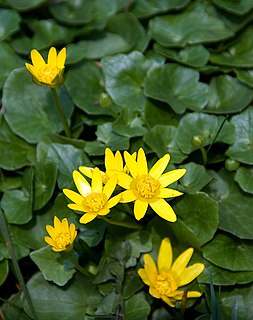
Ficaria verna, commonly known as lesser celandine or pilewort, is a low-growing, hairless perennial flowering plant in the buttercup family Ranunculaceae native to Europe and west Asia. It has fleshy dark green, heart-shaped leaves and distinctive flowers with bright yellow, glossy petals. It is now introduced in North America, where it is known by the common name fig buttercup and considered an invasive species. The plant is poisonous if ingested raw and potentially fatal to grazing animals and livestock such as horses, cattle, and sheep. For these reasons, several US states have banned the plant or listed it as a noxious weed. It prefers bare, damp ground and is considered by horticulturalists in the United Kingdom as a persistent garden weed; nevertheless, many specialist plantsmen, nursery owners and discerning gardeners in the UK and Europe collect selected cultivars of the plant, including bronze-leaved and double-flowered ones. Emerging in late winter with flowers appearing March through May in the UK, its appearance across the landscape is regarded by many as a harbinger of spring.

Ranunculus is a large genus of about 600 species of flowering plants in the family Ranunculaceae. Members of the genus are known as buttercups, spearworts and water crowfoots.

Ranunculus asiaticus, the Persian buttercup, is a species of buttercup (Ranunculus) native to the eastern Mediterranean region in southwestern Asia, southeastern Europe, and northeastern Africa.

Ranunculus repens, the creeping buttercup, is a flowering plant in the buttercup family Ranunculaceae, native to Europe, Asia and northwestern Africa. It is also called creeping crowfoot and sitfast.
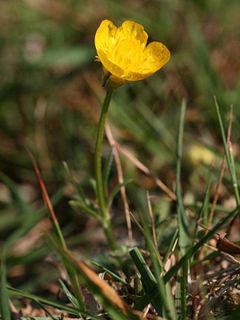
Ranunculus bulbosus, commonly known as bulbous buttercup or St. Anthony's turnip, is a perennial flowering plant in the buttercup family Ranunculaceae. It has bright yellow flowers, and deeply divided, three-lobed long-petioled basal leaves.

Ranunculus acris is a species of flowering plant in the family Ranunculaceae, and is one of the more common buttercups across Europe and temperate Eurasia. Common names include meadow buttercup, tall buttercup, common buttercup and giant buttercup.

Ranunculus lyallii, is a species of Ranunculus (buttercup), endemic to New Zealand, where it occurs in the South Island and on Stewart Island at altitudes of 700–1,500 m.

Ranunculus glaberrimus, the sagebrush buttercup, is a species of flowering plant in the buttercup family, Ranunculaceae. It is native to interior western North America, in western Canada, the western United States, and the northwestern Great Plains.
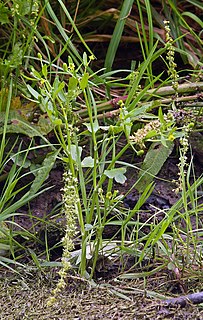
Ranunculus sceleratus known by the common names celery-leaved buttercup, celery-leaf buttercup, and cursed buttercup is a species of flowering plant in the buttercup family Ranunculaceae. It has a circumpolar distribution in the northern hemisphere, native to temperate and boreal North America and Eurasia, where it grows in wet and moist habitats, including ponds and streambanks.
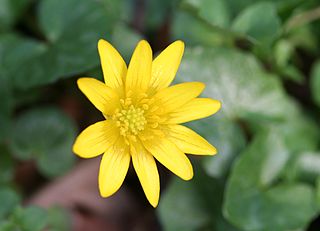
Ficaria is a small genus of several species of plants in the family Ranunculaceae, which were previously grouped with Ranunculus. The genus includes Ficaria verna, known as fig buttercup or lesser celandine, and related species. The name "Ficaria" is Classical Latin for fig. Plants in the genus are closely related to true buttercups, but generally have only three sepals and swollen smooth achenes.

Ranunculus aconitifolius, the aconite-leaf buttercup or bachelor's buttons, is a species of flowering plant in the buttercup family Ranunculaceae, native to central Europe. Growing to 60 cm (24 in) high by 40 cm (16 in) broad,it is an herbaceous perennial with slightly hairy palmate leaves up to 20 cm (8 in) long, and loose panicles of white, saucer-shaped flowers in spring.

Ranunculus muricatus is a species of buttercup known by the common names rough-fruited buttercup and spinyfruit buttercup. It is native to Europe, but it can be found in many other places in the world, including parts of Africa, Australia, and the western and eastern United States, as an introduced species and agricultural and roadside weed. It grows in wet habitats, such as irrigation ditches. It is an annual or sometimes biennial herb producing a mostly hairless stem up to half a meter long which may grow erect or decumbent along the ground. The leaves have blades a few centimetres in length which are deeply divided into three lobes or split into three leaflets. They are hairless to hairy in texture, and are borne at the tips of long petioles. The flower has five shiny yellow petals under 1 centimetre (0.4 in) long around a lobed central receptacle studded with many stamens and pistils. The fruit is a spiny achene borne in a spherical cluster of 10 to 20.

Ranunculus auricomus, known as goldilocks buttercup or Greenland buttercup, is a perennial species of buttercup native to Eurasia. It is a calcicole typically found in moist woods and at the margins of woods. It is apomictic, and several hundred agamospecies have been recognised.

Ranunculus lappaceus, commonly known as the common buttercup, Australian buttercup or Yarrakalgamba, is found across eastern Australia. Like buttercups elsewhere, it is a perennial herb with yellow flowers appearing in spring and summer.

Ranunculus pedatifidus is a species of buttercup known by the common names surefoot buttercup, northern buttercup, and birdfoot buttercup. It has a circumpolar distribution, occurring throughout the northern latitudes of the Northern Hemisphere. There are two varieties, var. pedatifidus occurring mostly in Asia and var. affinis mostly native to North America.
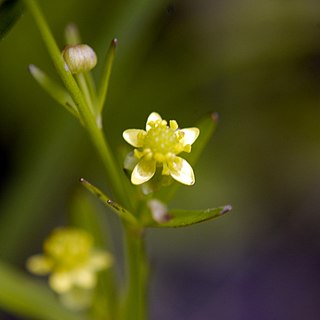
Ranunculus abortivus is a species of flowering plant in the buttercup family, Ranunculaceae. Its common names include littleleaf buttercup, small-flower crowfoot, small-flowered buttercup, and kidneyleaf buttercup. It is widespread across much of North America, found in all ten Canadian provinces as well as Yukon and the Northwest Territories, and most of the United States, except Hawaii, Oregon, California, and parts of the Southwest.

Ranunculus acaulis, in Australia and New Zealand called dune buttercup, sand buttercup or shore buttercup, is a yellow-flowered, small, fleshy herb, that grows in mats in damp places mostly near the sea. It occurs naturally in Australia, New Zealand, Chile and the Falklands. It flowers between August and April and sets seed from September till July.

Ranunculus amphitrichus, commonly known as the small river buttercup, is a species of buttercup found in southeastern Australia and New Zealand.

Ranunculus inundatus, commonly known as the river buttercup, is a species of buttercup found in eastern Australia.
Ranunculus dissectifolius is a rare species of buttercup found in alpine Australia.


















